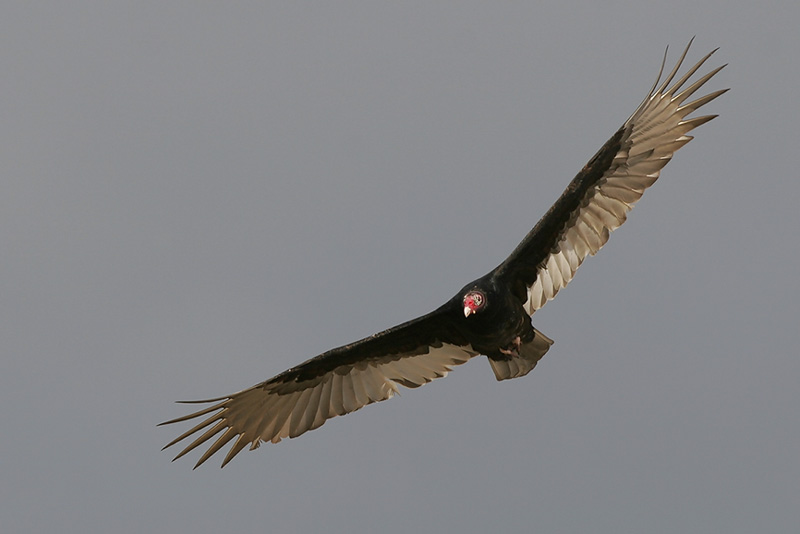The Turkey Vulture is one of the most common scavenging birds in North America.
Common and easily seen, the Turkey Vulture spends much of its time on the wing, searching for recently deceased animals and other types of carrion in forests, wetlands, grasslands, deserts, and other places.
On this page
Identification
The Turkey Vulture is a large, soaring bird in the New World Vulture family. Although it’s not quite as big as an eagle, the long, broad wings and long tail can give the Turkey Vulture an imposing appearance, and, at close range, this bird of prey can look much larger than its actual size.
Even so, with a length a bit more than two feet, and a five-foot plus wingspan, the Turkey Vulture is still a big and impressive bird.
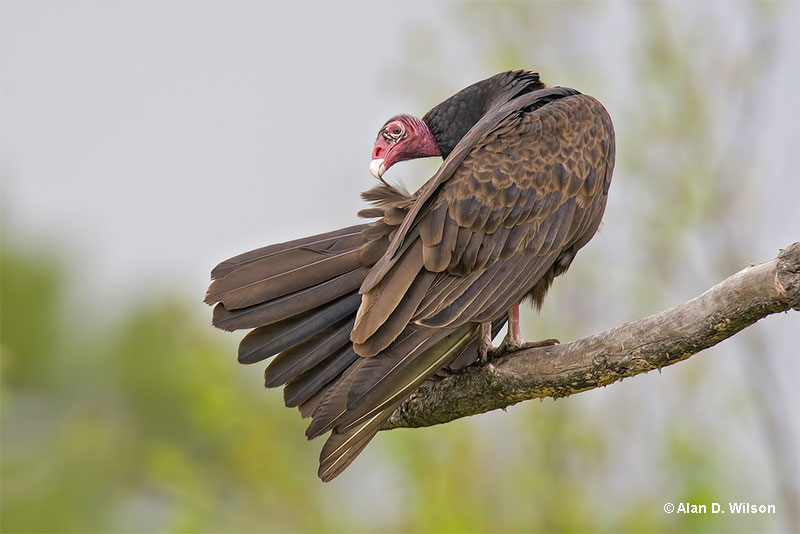
© Alan D. Wilson
As with other birds of prey, female Turkey Vultures are larger than males, the biggest females having a length of 32 inches and a wingspan of nearly 6 feet, and the smallest males a length of 25 inches and 67-inch wingspan. They weigh around four pounds, and both sexes have the same appearance.
The Turkey Vulture has entirely blackish plumage with sooty brown highlights, and slightly paler flight feathers that contrast with the rest of the wing. This contrast is very noticeable when Turkey Vultures soar overhead although good views of the small, naked, red head and white bill can require a close look.
The wings are long, held in a shallow “V” shape, and are often used for soaring high overhead. However, when a Turkey Vulture takes off, it moves its wings with slow, big flaps. The tail has the same grayish color as the flight feathers and is fairly long.
This vulture species also has medium-length, pinkish legs, and the juvenile Turkey Vultures resembles adult birds but has a black head.
Food
Throughout its wide range, the Turkey Vulture feeds almost entirely on carrion. This scavenger is very adaptable, and although it may have a preference for recently deceased small mammals, it also eats an ample variety of dead wild animals and deceased domestic animals.
Other food items have included everything from dead tadpoles in dried-out ponds to dead grasshoppers, a floating dead alligator, and many road-killed animals.
In general, the Turkey Vulture adapts to eating whatever dead animals are available where it happens to live. For example, Turkey Vultures in deserts may eat more reptiles, whereas those living in farmlands may eat dead animals associated with farms.
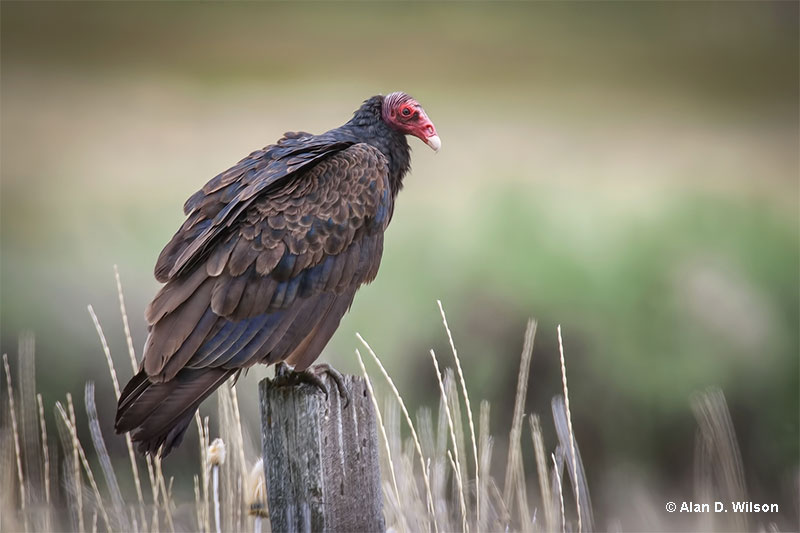
On rare occasions, this bird also kills and eats small animals but only when the prey are in situations where they can’t escape or defend themselves. The Turkey Vulture forages for carrion and other food by soaring high in the air and wandering over a certain area until it finds carrion.
In forested regions, it mostly relies on its sense of smell to find food but also looks for food in open habitats.
When Turkey Vultures detect food, they fly down to inspect the situation, and if the animal is dead, the vulture will start to peck at and eat softer parts. If it finds a dead animal with thick skin that cannot be penetrated by its rather weak bill, the Turkey Vulture waits until Black Vultures or other birds or animals can rip open the dead animal.
Nesting and Eggs
In spring, both sexes choose a nest site, sometimes the same site from previous years. Turkey Vultures often nest in caves, but they can also choose a hollow log, a spot beneath dense shrubbery, an abandoned building, or other dark, secluded, and protected spots. They much prefer to nest in places well away from any type of disturbance made by people.
Instead of bringing any materials to build a nest, the female lays two creamy or dull white eggs with reddish or purple blotches near the large end of the egg, on the ground or whatever substrate is present.
The eggs can weigh 67.6 grams to 92.6 grams and are incubated by both parents for 28 to 40 days.
After hatching, the down-covered young are fed regurgitated food by both parents for seven to eight weeks. As they grow, they move around more frequently within the nest but don’t leave it until they can fly for a short distance.
After leaving the nest, young Turkey Vultures stay in the area and continue to be fed by their parents for one to three weeks. After that time, they join communal roosts of other vultures and don’t spend any more time with their parents, not even during migration.
Current Situation
Within its range, the Turkey Vulture seems to occur in just about every habitat possible. From southern Canada to the entire USA and further south, soaring individuals can be seen over towns, wetlands, forests, and other habitats.
In fall, millions of Turkey Vultures that breed in the northern, central, and western United States migrate to South America, and then return north again in spring. During migration, in southern Texas, Mexico, and Central America, huge numbers can be seen flying from one end of the horizon to the other.
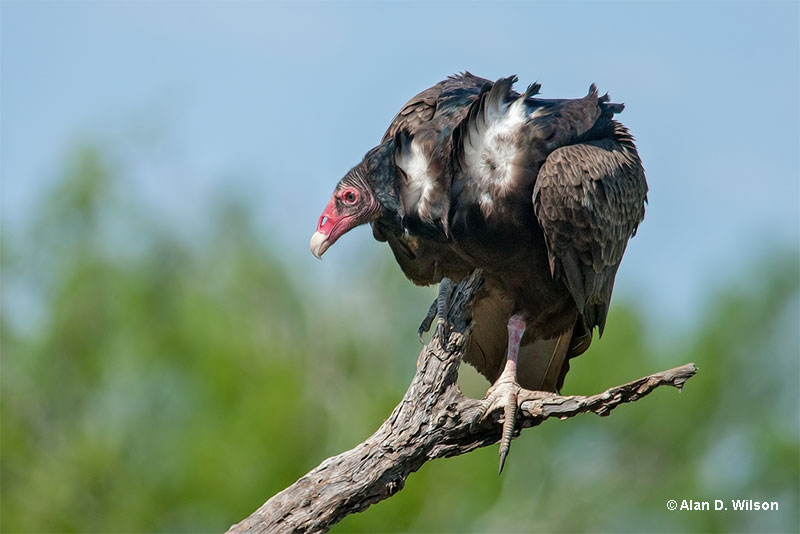
© Alan D. Wilson
This bird species is common, easy to see, and is not endangered. In the first half of the 20th century, sadly, the Turkey Vulture was believed to pose a threat to livestock and was therefore persecuted as a pest in Texas and some other places.
Fortunately, this persecution has largely stopped and although a number of birds still die from collisions with cars and power lines, and are injured and die in leg-hold traps put out for mammals, the population of the Turkey Vulture still seems to be large and stable.
Facts
- The Turkey Vulture, condors, and other vultures in the Americas are placed in their own avian family and not with the vultures of Europe, Africa, and Asia. Those big scavenging birds are much more closely related to hawks, and eagles.
- To detect leaks in pipelines, the pipes of natural-gas companies carry an odor that attracts Turkey Vultures. If a leak occurs, thanks to their amazing sense of smell, Turkey Vultures quickly gather and indicate where the leak is happening.
- Both sexes of this species have two incubation patches, one on either side of the lower breast.
- Turkey Vultures can be a hazard for airplanes, especially military training flights, because they are big and fly at similar altitudes as military planes. From 1989 to 1992, collisions between this species and aircrafts resulted in two deaths and losses of 21.6 million dollars.
- Vultures are often considered to be bad omens, but in reality, they are just like other birds.
Similar Species
The Turkey Vulture is a distinctive species with soaring flight that makes it easy to watch for extended periods of time. However, there are a few species that look similar.
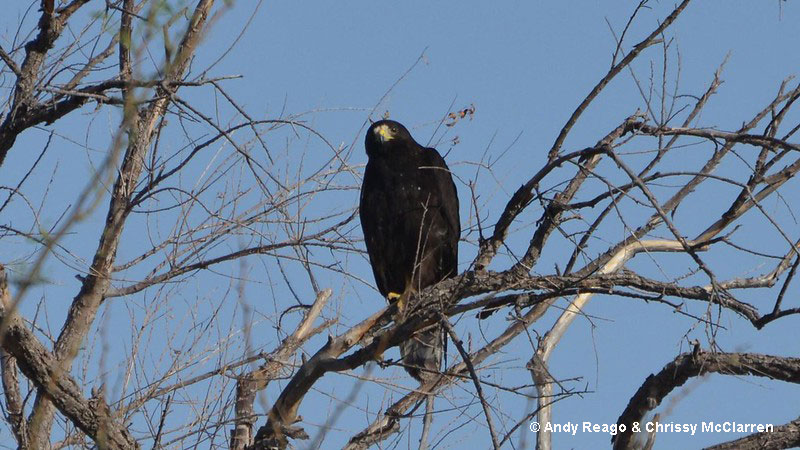
© Andy Reago & Chrissy McClarren
The Zone-tailed Hawk of the American southwest looks very much like a Turkey Vulture in flight. This is no coincidence because the hawk mimics the vulture and often flies with groups of vultures to sneak up on and catch small mammals and birds.
To separate it from the Turkey Vulture, look for white in the tail and a more rounded, hawk-shaped head.
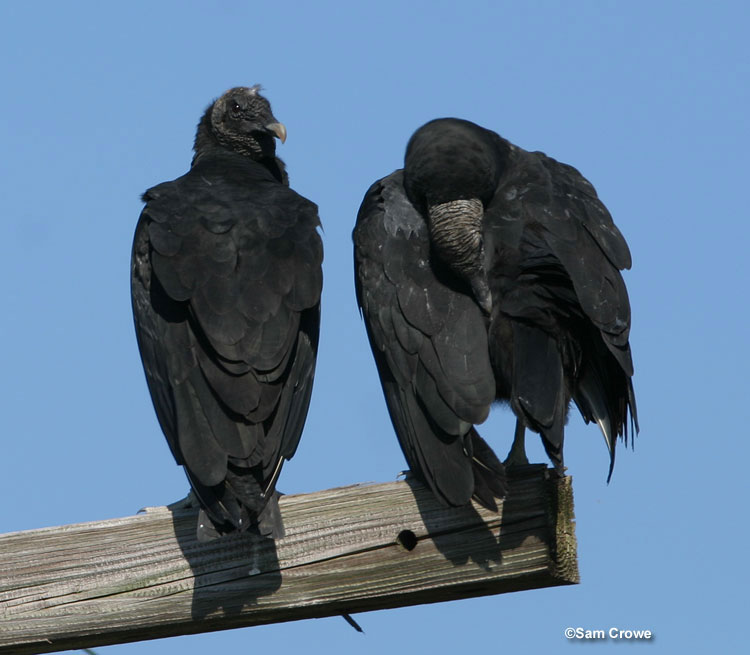
Black Vultures
The Black Vulture is similar to and often flies with the Turkey Vulture but the Black Vulture has broader wings with a prominent whitish patch at the base of the primaries, a black head, and a shorter tail.
They also hold their wings flatter than the Turkey Vulture does.
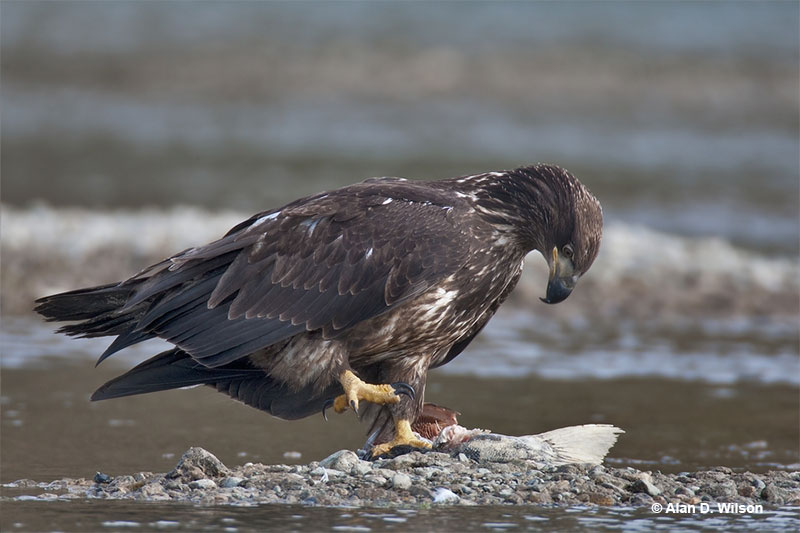
Juvenile Bald Eagle. Photograph © Alan D. Wilson
Immature Bald Eagles are also occasionally confused with Turkey Vultures.
They are larger with a much bigger head, hold their wings flatter, and usually have some white mottling in their plumage.
Frequently Asked Questions
Are Turkey Vultures harmful?
Turkey Vultures are not harmful. Turkey Vultures are beneficial birds that remove large amounts of carrion from the countryside.
What is the difference between a vulture and a Turkey Vulture?
The Turkey Vulture is a type of vulture with a red head and long wings usually held slightly above the body in a shallow “V”.
What does it mean when you see Turkey Vultures?
Seeing a Turkey Vulture can be a reminder to let go and allow life to bring you where you need to be. This species can also remind us of the benefits of being adaptable, patient, and innovative.
Do Turkey Vultures eat live animals?
Rarely, Turkey Vultures will eat small, live animals. This usually happens in situations where the animals are near death or helpless.

